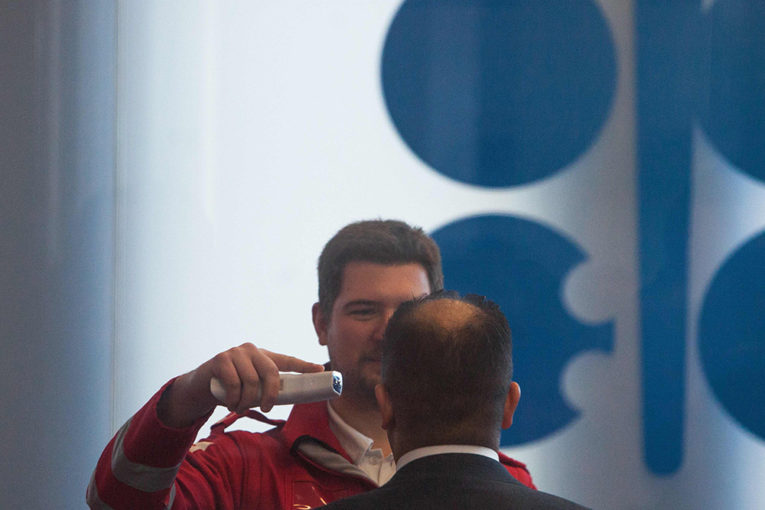
The country’s largest petroleum producer has modestly trimmed its spending plan for the year, while other oilpatch companies are scrutinizing their capital programs in the wake of crumbling crude prices.
Benchmark oil prices have plunged by 25 per cent since the start of the year, largely because of growing concerns about the economic effect of the new coronavirus on energy demand.
Canadian Natural Resources Ltd. announced Thursday it is pulling $100 million out of the company’s oilsands mining and upgrading capital budget “due to the volatile state of the current crude oil price environment.”
The move leaves its overall spending target for the year at $3.95 billion. President Tim McKay said the company could adjust spending further, if required.
“We could reduce our capital anywhere from $300 (million) to $400 million,” McKay said on a conference call Thursday as the company released its fourth-quarter results.
“We will evaluate after … the April-May time frame how it’s looking.”
Across the Canadian oilpatch, similar budget reviews are going on in executive offices as oil prices have tumbled in the past two months.
Prices for benchmark West Texas Intermediate crude closed Thursday at $45.90 a barrel, down 88 cents. On Friday, oil fell sharply by more than $4 to close at $41.90 a barrel.
“The mood right now is very much one of concern and people are already reacting or getting ready to react by reducing capital,” said NuVista Energy Ltd. CEO Jonathan Wright.
“I don’t know anyone that isn’t having a conversation about reducing capital if this goes on for an extended period of time.”
Due to the sudden price drop, the Organization of Petroleum Exporting Countries (OPEC) met Thursday and is considering a significant production cut of an additional 1.5 million barrels per day to help stabilize the market.
The situation is dynamic and it’s uncertain how long the coronavirus will continue to spread or affect the global economy.
The virus has reportedly caused more than 3,200 deaths and spread to 80 countries. Alberta reported its
first presumptive case of the virus
Thursday.
Related
Judith Dwarkin, chief economist with RS Energy Group (a part of Enverus), estimates the economic fallout from COVID-19 will chop expected demand growth for oil by almost half this year, down to about 600,000 barrels per day.
If OPEC locks in the larger production cuts, it should help the psychology of the market and provide some underlying support for oil prices.
“Right now, the market it seems is running on fear and uncertainty,” Dwarkin said.
In the wake of such turbulence, most companies are reacting cautiously.
In an interview, McKay said efficiency measures were also behind the company’s spending reduction in the oilsands. The ongoing price volatility could lead to more cuts, which would likely affect drilling in Alberta during the second half of the year.
“I see it as a short-term cycle that companies will have to manage through,” he added.
Some Canadian producers plan to spend near the bottom end of their original guidance to the market and expect to re-examine their capital expenditures in April or May.
Earlier this week, Tourmaline Oil Corp. announced its capital plan will remain at $925 million, but noted it will monitor commodity prices over the next few months. It has the flexibility to reduce capital spending by $100 million, it said in a release.
NuVista Energy will stick with its capital budget of $300 million to $330 million, but will likely spend toward the lower end of that range, Wright said.
“We are in the middle of a winter drilling season and you destroy value by shutting down activities in a knee-jerk fashion, especially when you don’t have to,” he said.
But if prices remain low for the rest of the year, it would cut capital expenditures “because we’re just not going to run up a large debt,” he added.
It’s been a sudden shift in the outlook for Canadian petroleum producers since the start of the year.
Companies entered 2020 welcoming progress on pipelines, growing crude-by-rail shipments, higher commodity prices and some tentative signs of investor interest.
A report by AltaCorp Capital this week noted non-oilsands producers have signalled spending will fall by 2.1 per cent on average. Oilsands operators are expected to spend 7.2 per cent more than last year.
Surge Energy Inc. CEO Paul Colborne said his company has already pushed back some capital spending until the second half of 2020, reducing the number of wells it will drill in the first quarter.
He expects other producers will do the same in the coming weeks.
“The price drop has made us just cautious. And we’ve had so many body blows in the last six years that we’re very nimble to make these corrections,” he said.
Industry leaders note a dip in the Canadian dollar and a narrower-than-expected price differential for western Canadian crude have helped offset some of the sting of falling global oil prices.
Canadian producers have also become more cost-effective in recent years, better able to withstand lower prices than they were when oil dropped below US$40 a barrel four years ago.
Tamarack Valley Energy Ltd. CEO Brian Schmidt said his company has kept its capital program intact at $170 million to $180 million this year, noting it can make money at current prices.
“We will, so far, continue on with our budget, but a lot of people in town need to look at cutbacks because balance sheets will get stretched,” he added.
For a year that began with promise, it’s been a jarring switch as oil prices have plunged and the global economy has decelerated.
With economic concerns rising, more tough decisions about scaling back spending could be coming later in the spring.
Chris Varcoe is a Calgary Herald columnist.
You can read more of the news on source
